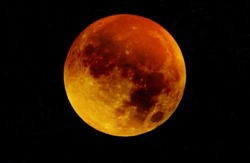
A total lunar eclipse occurs when the Earth passes between the Sun and Moon, and lines up precisely so that it completely blocks the Sun’s light, which otherwise reflects off the Moon. A lunar eclipse can occur only when there is a full Moon.
Totality—the time the Moon will spend in the Earth’s shadow— will last 1 hour and 2 minutes. The eclipse will begin when the Moon enters the faint outer portion (called the penumbra) of the Earth’s shadow about an hour before it begins moving into the umbra. The penumbra, however, is all but invisible to the eye until the Moon becomes deeply immersed in it. Sharp-eyed viewers may get their first glimpse of the penumbra as a faint “smudge” on the left part of the Moon’s disk about a half hour after it first enters the penumbral shadow. See Eclipse Timetable, below.
The most noticeable part of this lunar eclipse will come when the Moon begins to enter the Earth’s dark inner shadow (called the umbra). A small scallop of darkness will begin to appear on the Moon’s left edge shortly after it has begun to enter the umbra.
Eclipse watchers from the Hawaiian Islands will see a different—but still stirring—spectacle: the eclipse will already be in progress when the Moon rises at sunset, with roughly half of the Moon already immersed in shadow. As evening twilight deepens and the Moon gradually becomes more and more immersed in the Earth’s shadow, it will become transformed into a ruddy, ghostly orb.
During a lunar eclipse, the Moon can sometimes turn red. The light reaching the Moon resembles the “color of blood,” and is sometimes called a “Blood Moon” which can be a bit unsettling. But the explanation is simple:
“During a total lunar eclipse, white sunlight hitting the atmosphere on the sides of the Earth gets absorbed and then radiated out (scattered). Blue-colored light is most affected,” NASA officials wrote online. “That is, the atmosphere filters out (scatters away) most of the blue-colored light. What’s left over is the orange- and red-colored light.”
January 20-21 Total Lunar Eclipse Timetable
| HIST | AKST | PST | MST | CST | EST | |
| Moon Enters Penumbra | — | — | 6:36p | 7:36p | 8:36p | 9:36p |
| Moon Enters Umbra | — | 6:34p | 7:34p | 8:34p | 9:34p | 10:34p |
| Total Eclipse Begins | 6:41p | 7:41p | 8:41p | 9:41p | 10:41p | 11:41p |
| Mid-Eclipse | 7:13p | 8:13p | 9:13p | 10:13p | 11:13p | 12:13a |
| Total Eclipse Ends | 7:43p | 8:43p | 9:43p | 10:43p | 11:43p | 12:43a |
| Moon Leaves Umbra | 8:51p | 9:51p | 10:51p | 11:51p | 12:51a | 1:51a |
| Moon Leaves Penumbra | 9:48p | 10:48p | 11:48p | 12:48a | 1:48a | 2:48a |
While the Farmers’ Almanac is mostly known for its advance weather forecasts, it has also been an important astronomy resource for over two centuries, including eclipses and full Moons.
For more information, visit www.FarmersAlmanac.com.



